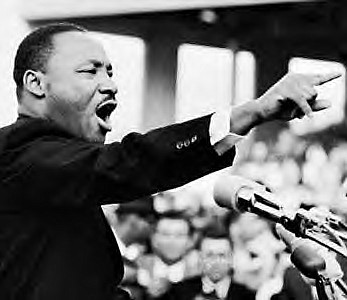
NONVIOLENT RESISTANCE
During the time of the bus boycott, King overcame arrest and other violent harassment, including bombing of his home on January 30, 1956.
The inspiration of Mahatma Gandhi began to exert its influence…People who had never heard of him had become familiar with who he was. “Nonviolent resistance emerged as the technique of the [civil rights] movement, while love stood as the regulating ideal. In other words, Christ furnished the spirit and motivation while Gandhi furnished the method.”[1]
To believe in nonviolence does not mean that violence will not be inflicted upon you. A person who believes in nonviolence will willingly allow himself to be the victim of violence but will never inflict violence upon another. He lives with the conviction that through his suffering and cross bearing, the social situation may be redeemed.
To participate in such protest marches participants had to be thoroughly trained. Accepting violence and not retaliating is not a natural way to behave. It takes great willpower to control your temptation to fight back. It’s a courageous confrontation of evil by the power of love.
King quotes what Gandhi said to his people: “If you are hit, don’t hit back; even if they shoot at you, don’t shoot back. If they curse you, don’t curse back. Just keep moving. Some of us might have to die before we get there. Some of us might be thrown in jail before we get there, but let us just keep moving.” [2]
THE POWER OF MARTIN LUTHER KING’S ANGER
Anger is a completely normal, usually healthy, human emotion. But most look at it as a problem when it goes out of control and turns destructive.
But, as Joann Ellison Rogers wrote in Psychology Today, anger is now understood as a tool for addressing problems head on instead of running from them or standing around fuming. Anger can propel one forward to address the issue at hand. [3]
Autobiographies reveal stories of how the initial action for peace and justice were motivated by anger against injustice. King’s story is one.
According to Dr. Monique Turner of Michigan State University, “Anger is known to be a precursor to social activism that motivated people to act on their sense of injustice of concern, it can engender a sense of ‘rightness’ about their behavior.” [4]
King’s handling of his anger shows its dual nature. Although anger has the potential for destruction, it can also be a motivating force for change. King was an example of someone who was able to turn anger into positive action. It helps us appreciate how the entire civil rights movement was saved by King’s decision to go with nonviolent protests.
[1] The Autobiography of Martin Luther King – Page 67
[2] The Autobiography of Martin Luther King, Jr. – Page 128, 129
[3] Anger as a Catalyst of Change, Derek Beres, https://bigthink.com/21st-century-spirituality/anger-as-a-catalyst-of-change
[4] Harnessing Anger for Social Change, Research Outreach, https://researchoutreach.org/articles/harnessing-anger-social-change/
This has been Part 52 of the Series A Life Worth Living. Read Part 53 – How angry do you get?
Leave a Reply